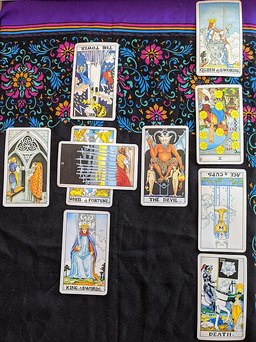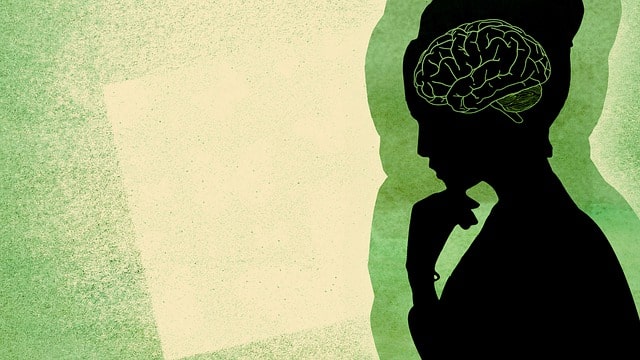
There are many spreads you can use when doing a tarot reading. But, the Celtic cross tarot spread is one of the most popular spreads used by many tarot practitioners.
But why? It’s one of the hardest spreads you can use. If you didn’t know, it’s really easy to miss details and connections with the Celtic cross tarot spread.
That’s just it, though. It’s difficult because it’s comprehensive! It can show so much nuance and interrelationships between cards. You can find out so much if you take the time to properly analyze the cards and how they connect with each other.
In a nutshell, it’s easy to learn and hard to master. And you will be greatly rewarded if you decide to hone your skills with this spread. With that said, let’s look at how to read the Celtic tarot spread.
Celtic Cross Tarot Spread Layout
The first thing you need to know is the Celtic cross tarot layout. The Celtic cross spread is made up of 10 cards. It looks like a cross made up of 5 cards with a card lying on top of the middle card. It also has a staff made of 4 cards to the right of the cross.
Pay attention to the position as well as the order that you play the cards.
1st card: Middle card of the cross
2nd card: On top of the 1st card
3rd card: Left card of the cross
4th card: Right card of the cross
5th card: Top card of the cross
6th card: Bottom card of the cross
7th card: Bottom card of the staff
8th card: Second to the bottom card of the staff
9th card: Second to the top card of the staff
10th card: Top card of the staff
Celtic Cross Tarot Spread Position Meanings
Aside from the position of the cards in the Celtic cross tarot spread, you will also need to know the meanings of these cards.
1st Card: What Is In The Present?
The first card signifies the present situation of the person requesting a reading. With this card, you can discern which details are relevant pertaining to the situation. If there is any problem that needs immediate fixing, for example, this card will show itself.
But more than that, you can also gain insight into the mindset of your asker. Specifically, you can glimpse into how they perceive and feel about their current situation. You can then use this insight to help deal with the reader’s problems. And since there is universality in human experience, you might actually find useful solutions yourself.
2nd Card: What Currently Challenges You?

The second card represents an issue or a problem that the asker is facing at the moment. In a nutshell, everything would go a lot better if the asker fixed the issue this card represents. It is also an opportunity for character development on their part.
Be careful that you don’t fall into the common trap of thinking a positive card here means there are no problems. In fact, you would be right to expect so, since the world of the asker is not perfect. Even the more positive cards can present issues depending on context and perspective, so be thorough.
3rd Card: How Is The Past Relevant?
The third card represents the past. Specifically, it speaks about the events that have led up to the present. Looking into what this card is trying to say can provide insight into the origin of the question or issue at hand.
This can also provide both you and the asker further context to work on. Pay attention to the ripples of the past that may appear in the reading. This will help you pinpoint the problems or provide further clarity.
4th Card: What Does The Future Hold?
The fourth card represents the future. When you look into this card, remember that it does not show the conclusion or the end. It simply shows what can happen in a matter of days, or weeks, or even months.
Be careful not to give the asker too much advice when doing this reading. Instead, guide them into having the right mindset for the challenges or victories ahead. That way, they will be able to walk to a better future.
5th Card: What Are You Reaching For?

The fifth card represents an ideal conclusion. This is often the best-case scenario that your asker is working towards. You can use this card to look into your asker’s motivations and plans. It can provide valuable insight on whether or not they’re on the right track.
Use this opportunity to try and glean into the asker’s present situation. Their current context will provide you ample opportunities to advise them on what to do next. Be the objective eye the seeker sorely needs.
6th Card: What Do You Yearn For Deep Down?
The sixth card represents the subconscious, in contrast with the fifth card. This card seeks to go beyond the superficial details and look into the asker’s inner psyche. By doing this, you may be able to see the emotions and patterns behind the asker’s actions.
There is much potential for new insight in this card, especially if the asker isn’t very in tune with their inner self. What truly drives them might not be what they expect. And more importantly, this can be a moment of self-discovery that helps the asker self-actualize.
7th Card: What Should You Do?
The seventh card focuses the energies and messages of the other cards and represents a plan of action. This card often presents a suitable course of action that the asker can take when approaching the situation.
When talking about the seventh card, do not hesitate to critique the asker. The goal here is to help the asker find meaningful change in their hearts. This means acknowledging and correcting any weaknesses. Spare no detail when giving instructions.
8th Card: How Can Outside Forces Influence You?

The eighth card represents external forces outside the asker’s sphere of influence. Like everything in life, we can’t control everything. As such, it would be a mistake to ignore this card and the message it brings.
If the asker asks for your help, do so by looking into their personal turmoil. They may not be able to change the world around them, but they can change their thinking. Once they have the correct mindset, they will be well-equipped.
9th Card: What Scares You and What Drives You?
The ninth card looks into the asker’s hopes and fears. Like many of the cards in the staff, this card is a valuable source of insight and perspective. Things like what the asker’s dreams are and what they fear are integral parts of their character.
Take note that these two concepts are closely intertwined and may make the card difficult to interpret. After all, our fears are often tied to our dreams not coming to fruition or some variation of it.
10th Card: How Will Your Plan Play Out?
The tenth and final card represents the conclusion. It describes how the situation at hand can play out in the end. However, this card only describes how things happen should the asker stay on their current path.
What this means is that this card gives the asker the agency to choose their own path. If the card is positive, they can continue on their path with confidence. And if the card is negative, they are free to change their mind and act differently.
